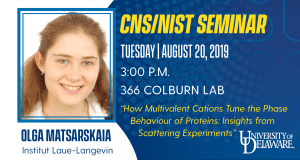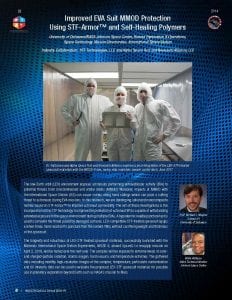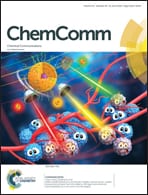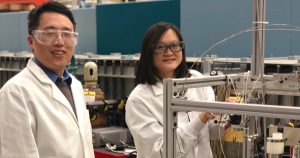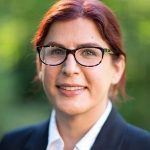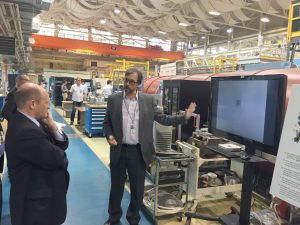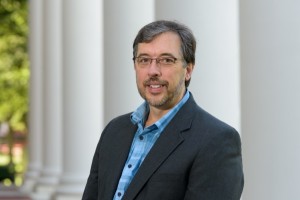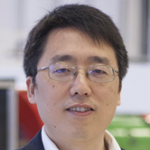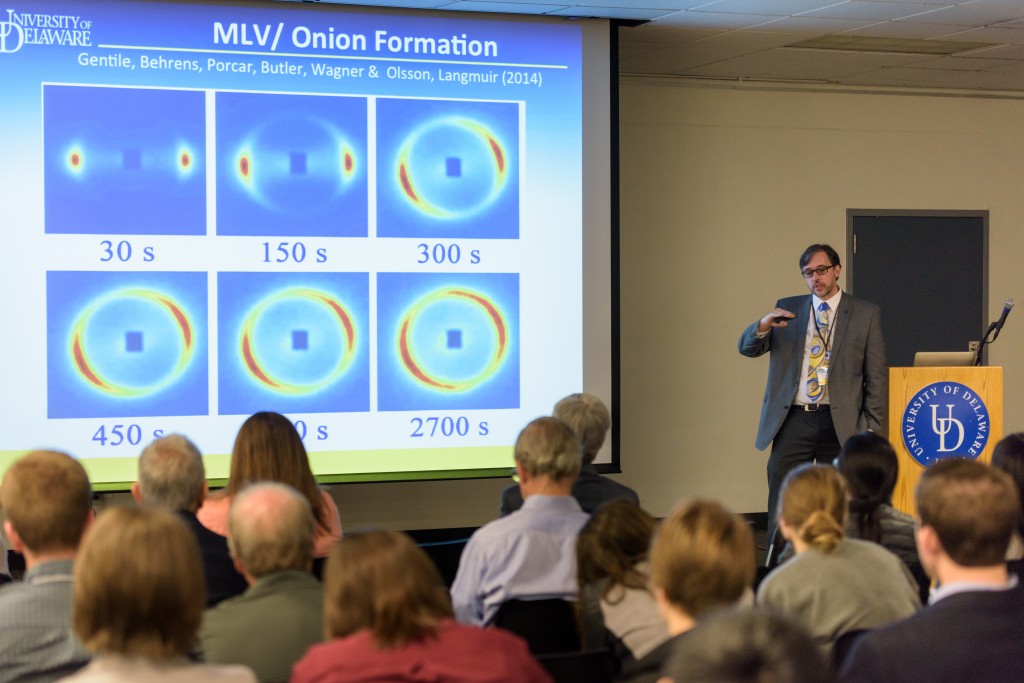
Small Angle Neutron Scattering pattern from a flowing self-assembled surfactant system.
The Center for Neutron Science at the University of Delaware is a cooperative agreement between the (UD) and the National Institute of Standards and Technology (NIST) Center for Neutron Research (NCNR) to explore and develop new areas of neutron scattering science, with emphasis on strengths in complex fluids, macromolecular science, and condensed matter physics. This partnership will enhance the small angle neutron scattering (SANS) capabilities of the United States, and thereby, make them available to a large scientific user community. It also help train the next generation of neutron scientists and engineers for careers in support of the national nanotechnology initiative. SANS is a powerful probe of molecular and nanoscale structure, supramolecular order and dynamics, and can be used to monitor chemical and field-induced transformations. Because the technique requires a high-flux neutron source, SANS measurements are carried out at large national facilities, of which there are only four in the US. This cooperative agreement builds on the world-recognized expertise in SANS in the Departments of Chemical Engineering and Materials Science and Engineering at the University of Delaware and their long-standing scientific collaborations with the US’ premier neutron scattering facility NCNR at NIST. The goals of the cooperative agreement include: the operation of SANS instrumentation at NCNR; exploration of new scientific applications of neutron scattering measurements; the development of new SANS instrumentation; the development of new educational and training materials for use at UD, NIST and more broadly in support of the national neutron user community.
UD tapped to lead development of world-class neutron research instrument
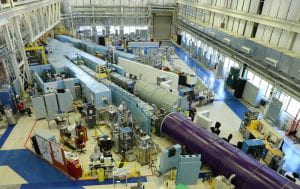
The University of Delaware will lead the development of a world-class neutron spin echo spectrometer, which will be installed at the National Institute of Standards and Technology’s Center for Neutron Research, shown here.
The University of Delaware has been tapped to lead the development of a world-class neutron spin echo spectrometer for the United States. This scientific instrument will advance U.S. research on countless materials important to humanity, from new medicines to more powerful batteries. UD’s Norman Wagner, the Unidel Robert L. Pigford Chair in Chemical and Biomolecular Engineering and director of the Center for Neutron Science, will lead the project, which is funded by an $11.8 million grant from the National Science Foundation. “This groundbreaking research project brings distinction to the entire University of Delaware, and we are excited to see what the future will bring,” said UD President Dennis Assanis. “On behalf of our entire University, I want to offer heartfelt congratulations to Dr. Wagner and his research group on this remarkable accomplishment.” It is among the first awards in NSF’s Mid-Scale Research Infrastructure program, announced Sept. 17.
Read UDaily article
Center for Neutron Science team wins $11M grant from NSF
Senator Chris Coons congratulates University of Delaware’s Norm Wagner and Center for Neutron Science Team
Senator Chris Coons: “Congrats to @UDelaware’s Norm Wagner & his Center for Neutron Science team for winning an $11M grant from @NSF. This funding will help American scientists, NIST, UD, UMD & partners close an important gap by supporting both research & the best neutron measurement instrumentation.”
View Senator Chris Coons Tweet
Neutron Day 2019 – October 30th at Clayton Hall Conference Center
Register for Neutron Day
View Program
CNS/NIST Seminar – Tuesday, August 20, 2019 @3:00 p.m. in 366 Colburn Lab
Olga Matsarskaia, Institut Laue-Langevin, Grenoble, France “How Multivalent Cations Tune the Phase Behaviour of Proteins: Insights from Scattering Experiments”
Dr. Matsarskaia completed her Ph.D. studies in December 2018 in Frank Schreiber’s group at the University of Tübingen, Germany. Her research focused on the influence that multivalent cations have on the thermodynamics of proteins in solution. Her main methods involved various X-ray and neutron scattering techniques. Currently, she is a post-doctoral fellow in Bela Farago’s neutron spectroscopy group at the Institut Laue-Langevin in Grenoble, France, and focuses on the dynamics of proteins in crowded environments using neutron backscattering and complementary methods. View Abstract
Understanding Gas Storage in Cuboctahedral Porous Coordination Cages
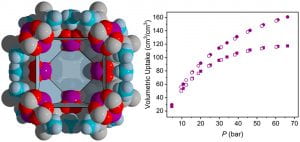
Bloch Group recently published a paper in JACS where neutron diffraction was used to study methane binding sites in porous materials
Gregory R. Lorzing, Eric J. Gosselin, Benjamin A. Trump, Arthur H. P. York, Arni Sturluson, Casey A. Rowland, Glenn P. A. Yap, Craig M. Brown, Cory M. Simon, Eric D. Bloch*
Porous molecular solids are promising materials for gas storage and gas separation applications. However, given the relative dearth of structural information concerning these materials, additional studies are vital for further understanding their properties and developing design parameters for their optimization. Here, we examine a series of isostructural cuboctahedral, paddlewheel-based coordination cages, M24(tBu-bdc)24 (M = Cr, Mo, Ru; tBu-bdc2– = 5-tert-butylisophthalate), for high-pressure methane storage. As the decrease in crystallinity upon activation of these porous molecular materials precludes diffraction studies, we turn to a related class of pillared coordination cage-based metal–organic frameworks, M24(Me-bdc)24(dabco)6 (M = Fe, Co; Me-bdc2– = 5-methylisophthalate; dabco = 1,4-diazabicyclo[2.2.2]octane) for neutron diffraction studies. The five porous materials display BET surface areas from 1057–1937 m2/g and total methane uptake capacities of up to 143 cm3(STP)/cm3. Both the porous cages and cage-based frameworks display methane adsorption enthalpies of −15 to −22 kJ/mol. Also supported by molecular modeling, neutron diffraction studies indicate that the triangular windows of the cage are favorable methane adsorption sites with CD4–arene interactions between 3.7 and 4.1 Å. At both low and high loadings, two additional methane adsorption sites on the exterior surface of the cage are apparent for a total of 56 adsorption sites per cage. These results show that M24L24 cages are competent gas storage materials and further adsorption sites may be optimized by judicious ligand functionalization to control extracage pore space. Read JACS article
2019 Cement Day
Leading Engineering for America’s Prosperity, Health, and Infrastructure
Tuesday, May 21, 2019
9:00 a.m. – 4:30 p.m.
Perkins Ewing Room
Improved EVA Suit MMOD Protection Using STF-Armor™ and Self-Healing Polymers
University of Delaware/NASA Johnson Space Center, Human Exploration & Operations, Space Technology Mission Directorates, International Space Station
The low-Earth orbit (LEO) environment exposes astronauts performing extravehicular activity (EVA) to potential threats from micrometeoroid and orbital debris (MMOD). Moreover, impacts of MMOD with the International Space Station (ISS) can cause craters along hand railings which can pose a cutting threat to astronauts during EVA missions. In this research, we are developing advanced nanocomposite textiles based on STF-Armor™ to improve astronaut survivability. The aim of these investigations is the incorporation of the STF technology to improve the protection of astronaut EPGs capable of withstanding extended exposure to the space environment during multiple EVAs. A hypodermic needle puncture test is used to simulate the threat posed by damaged surfaces. LEO-compatible-STF-treated spacesuit layups are two times more resistant to puncture than the current TMG, without sacrificing weight and thickness of the spacesuit. The longevity and robustness of LEO-STF-treated spacesuit materials, successfully launched with the Materials International Space Station Experiments, MISSE-9, aboard SpaceX-14 resupply mission on April 2, 2018, will be tested over the next year. The samples will be exposed to extreme levels of solar and charged-particle radiation, atomic oxygen, hard vacuum, and temperature extremes. The gathered data including monthly high-resolution images of the samples, temperature, particulate contamination and UV intensity data can be used to evaluate the proposed LEO-STF spacesuit materials for possible use in planetary exploration beyond Earth such as NASA’s mission to Mars. Industry Collaboration: STF Technologies, LLC and Alpha Space Test and Research Alliance, LLC View NASA EPSCoR ISS Stimuli 2018-19
Now Hiring: Post Doc Researcher
Chemical and Biomolecular Engineering, Center for Neutron Science
Deadline: Open until filled. A Postdoctoral Researcher position is currently available in the Center for Neutron Science under the Direction of Prof. Norman Wagner, Unidel Robert L. Pigford Chair in Chemical and Biomolecular Engineering, University of Delaware. The candidate will be expected to conduct experimental research on microstructure-rheology relationships in soft matter using techniques such as rheology, neutron and light scattering and allied methods of colloid and nanoscience. The research includes the development of new instrumentation under a recently awarded DOE contract, and the use of that instrument as part of an international collaboration investigating structure-property relationships in complex fluids under flow. The candidate must be able to work at the ORNL SNS/HFIR and the NIST Center for Neutron Research, as well as research facilities and universities internationally. The position includes limited administrative duties associated with agency reporting requirements. Successful candidates will have a PhD in engineering or science with expertise in rheology and/or scattering methods, as well as be familiar with and interested in scientific equipment design and construction. The position is available immediately, is for one year and is renewable, including benefits and a competitive salary based on qualifications.
How to Apply: When applying please submit a one-page cover letter and your resume as one document. Also, please remember to provide names, addresses and telephone number of at least three references in the online application. http://www.udel.edu/udjobs/Job ID106243
Equal Employment Opportunity: Employment offers will be conditioned upon successful completion of a criminal background check. A conviction will not necessarily exclude you from employment. The University of Delaware is an Equal Opportunity Employer which encourages applications from Minority Group Members, Women, Individuals with Disabilities and Veterans. The University’s Notice of Non-Discrimination can be found at http://www.udel.edu/aboutus/legalnotices.html
Highly Cited Researchers
Cathy Wu, Craig Brown and Anderson Janotti make list of top influencers
Engineers at the University of Delaware do research that garners attention from scientists and engineers around the world, and three faculty members in the College of Engineering were recently named to the Clarivate Analytics list of Highly Cited Researchers for 2018. This list identifies scholars whose publications are in the top 1% for citations by other researchers via Web of Science, a scientific citation indexing service. Researchers can be cited for top performance in their field or for Cross-Field impact, a new category this year. Read on for more about UD engineering’s highly cited academics.
Craig M. Brown is a staff chemist at the National Institute of Standards and Technology (NIST) center for Neutron Research and an adjunct professor through UD’s Center for Neutron Science, which was founded in 2007. Under a cooperative agreement with NIST, UD’s Center for Neutron Science advances the field of neutron scattering by developing new techniques, applying these techniques to new applications, and training the next generation of neutron scientists. Brown, who studies the structure and dynamics of novel materials, made the 2018 Highly Cited Researchers list in the Cross-Field category. Among his most cited works are papers on molecular adsorption for energy efficient industrial separations, and hydrogen storage in materials, which hold promise in applications for cleaner energy and automotive technology. Brown has published more than 175 peer-reviewed papers, which have garnered more than 12,000 citations. His work has an h-index of 50, and an i10-index of 144 based on Google Scholar. View College of Engineering News article
Journal of the American Chemical Society
Methane Storage in Paddlewheel-Based Porous Coordination Cages
Casey A. Rowland, Gregory R. Lorzing, Eric J. Gosselin, Benjamin A. Trump, Glenn P. A. Yap, Craig M. Brown, and Eric D. Bloch
J. Am. Chem. Soc.
DOI: 10.1021/jacs.8b05780
Publication Date (Web): August 18, 2018
Copyright © 2018 American Chemical Society
Although gas adsorption properties of extended three-dimensional metal-organic materials have been widely studied, they remain relatively unexplored in porous molecular systems. This is particularly the case for porous coordination cages for which surface areas are typically not reported. Herein, we report the synthesis, characterization, activation, and gas adsorption properties of a family of carbazole-based cages. The chromium analog displays a coordination cage record BET surface area of 1235 m2/g. With precise synthesis and activation procedures, two previously reported cages similarly display high surface areas. The materials exhibit high methane adsorption capacities at 65 bar with the chromium(II) cage displaying CH4 capacities of 194 cm3/g and 148 cm3/cm3. This high uptake is a result of optimal pore design, which was confirmed via powder neutron diffraction experiments. View JACS article
Soft Matter Journal Cover
Branching and Alignment in Reverse Worm-like Micelles Studied with Simultaneous Dielectric Spectroscopy and RheoSANS†
John K. Riley, Jeffrey J. Richards, Norman J. Wagner and Paul D. Butler
rsc.li/soft-matter-journal
Volume 14 | Number 26 | 14 July 2018 | Pages 5335–5538
ISSN 1744-6848 | DOI: 10.1039/c8sm00770e
Topology and branching play an important but poorly understood role in controlling the mechanical and flow properties of worm-like micelles (WLMs). To address the challenge of characterizing branching during flow of WLMs, dielectric spectroscopy, rheology, and small-angle neutron scattering (dielectric RheoSANS) experiments are performed simultaneously to measure the concurrent evolution of conductivity, permittivity, stress, and segmental anisotropy of reverse WLMs under steady-shear flow. Reverse WLMs are microemulsions comprised of the phospholipid surfactant lecithin dispersed in oil with water solubilized in the micelle core. Their electrical properties are independently sensitive to the WLM topology and dynamics. To isolate the effects of branching, dielectric RheoSANS is performed on WLMs in n-decane, which show fast breakage times and exhibit a continuous branching transition for water-to-surfactant ratios above the corresponding maximum in zero-shear viscosity. The unbranched WLMs in n-decane exhibit only subtle decreases in their electrical properties under flow that are driven by chain alignment and structural anisotropy in the plane perpendicular to the electric field and incident neutron beam. These results are in qualitative agreement with additional measurements on a purely linear WLM system in cyclohexane despite differences in breakage kinetics and a stronger tendency for the latter to shear band. In contrast, the branched micelles in n-decane (higher water content) undergo non-monotonic changes in permittivity and more pronounced decreases in conductivity under flow. The combined steady-shear electrical and microstructural measurements are capable, for the first time, of resolving branch breaking at low shear rates prior to alignment-driven anisotropy at higher shear rates. View Soft Matter article
Thomas H. Epps, III elected as a Fellow into the Royal Society of Chemistry
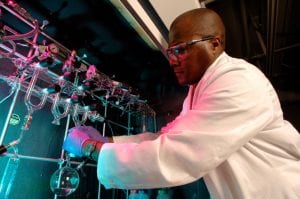 Thomas H Epps, III, the Thomas and Kipp Gutshall Senior Career Development Chair in Chemical and Biomolecular Engineering at University of Delaware and Director for the Center for Molecular & Engineering Thermodynamics (CMET), has been admitted as a Fellow of the Royal Society of Chemistry (RSC), a UK-based professional society with worldwide membership. The Fellow of the Royal Society of Chemistry (FRSC) designation is given to elected fellows who have made significant contributions to the chemical sciences.
Thomas H Epps, III, the Thomas and Kipp Gutshall Senior Career Development Chair in Chemical and Biomolecular Engineering at University of Delaware and Director for the Center for Molecular & Engineering Thermodynamics (CMET), has been admitted as a Fellow of the Royal Society of Chemistry (RSC), a UK-based professional society with worldwide membership. The Fellow of the Royal Society of Chemistry (FRSC) designation is given to elected fellows who have made significant contributions to the chemical sciences.
“It is a great honor to be appointed as a Fellow of the Royal Society of Chemistry,” says Epps. “Several of my colleagues at UD are Fellows of the RSC, along with other people who I admire in the polymers community in the United States and abroad. It is a great privilege to become a part of this esteemed group in chemistry. I am extremely grateful to all of my students, postdocs, and collaborators who have contributed to my activities.”
To learn more about Epps’s research, click here. For more information about the RSC, visit their official site.
Gas Adsorption in an Isostructural Series of Pillared Coordination Cages
Eric J. Gosselin, Gregory R. Lorzing, Benjamin A. Trump, Craig M. Brown and Eric D. Bloch
ChemComm
Issue 49, 2018
Department of Chemistry & Biochemistry, University of Delaware, Newark, USA
E-mail: edb@udel.edu
Center for Neutron Science, Department of Chemical and Biomolecular Engineering, University of Delaware
Center for Neutron Research, National Institute of Standards and Technology, Gaithersburg, USA
 The synthesis and characterization of two novel pillared coordination cages is reported. By utilizing 1,4-diazabicyclo[2.2.2]octane (dabco) as a pillar with increased basicity as compared to pyrazine or 4,4′-bipyridine, a stable copper-based material was prepared. Extending this strategy to iron(II) afforded an isostructural material that similarly retains high porosity and crystallinity upon solvent evacuation. Importantly, the iron solid represents a rare example of porous iron paddlewheel-based metal–organic material that is stable to solvent evacuation. Neutron powder diffraction studies on these materials indicate the triangular and square windows of the cage are prime ethane and ethylene adsorption sites.
The synthesis and characterization of two novel pillared coordination cages is reported. By utilizing 1,4-diazabicyclo[2.2.2]octane (dabco) as a pillar with increased basicity as compared to pyrazine or 4,4′-bipyridine, a stable copper-based material was prepared. Extending this strategy to iron(II) afforded an isostructural material that similarly retains high porosity and crystallinity upon solvent evacuation. Importantly, the iron solid represents a rare example of porous iron paddlewheel-based metal–organic material that is stable to solvent evacuation. Neutron powder diffraction studies on these materials indicate the triangular and square windows of the cage are prime ethane and ethylene adsorption sites.
2018 Sustained Research Prize

Professor Norman J. Wagner, Center for Neutron Science, Department of Chemical & Biomolecular Engineering, University of Delaware
NSSA Announces the 2018 Prize Recipients
Professor Norman Wagner
University of Delaware is the recipient of the 2018 Sustained Research Prize of the Neutron Scattering Society of America (NSSA) with the citation: “For his seminal and sustained contributions to our understanding of soft condensed matter physics using neutron scattering.”
View Neutron Scattering Society of America Newsletter<
New method could help quantify untapped natural gas reservoirs
More than 30 states have shale formations that harbor natural gas underground, according to the Energy Information Administration. But industry experts can’t agree on exactly how much fuel is inside. That’s because natural gas and other hydrocarbons lie inside nano-scale, difficult-to-measure pores in shale rocks, which have properties that are not yet understood. “If you want to estimate the storage capacity of shale gas, you need to understand materials that store them,” said Yun Liu, an affiliated associate professor of chemical engineering at the University of Delaware and a physicist at the National Institute of Standards and Technology (NIST) Center for Neutron Research. Now, using neutron scattering, Liu and a team of researchers from UD, NIST and Aramco Services Company have developed a novel non-invasive method to measure the variation of surface properties deep inside porous materials. This method can help natural gas experts to better understand shale samples by examining the compositional distribution on porous surfaces inside the shales that directly influences the storage and transport of hydrocarbons. This would eventually help them decide whether to invest time and resources to extract gas from the formation the samples came from. The findings of this study, published Thursday, Feb. 22 in the journal Nature Communications: A non-invasive method to directly quantify surface heterogeneity of porous materials, could also be used to understand many other different types of porous materials using neutron scattering or X-ray scattering.
Investigating pores
It’s not just the size of pores that matters, but the surface structure and surface chemistry, since natural gas interacts with the outer edges of each tiny pore in the rock. The properties of the pores also determine how gas will flow out of the formation. To understand these pores…
View publication in Nature Communications
Want a Tougher Space Suit? Just Add Liquid
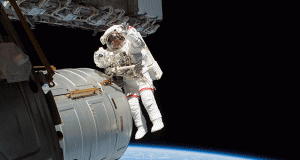
Astronauts don bulky suits to protect themselves as they “walk” outside the International Space Station. A new material might one day make those suits even more protective.
NASA
A New Material Might Give Astronauts Better Space Suits that are Strong, Thin and Light
Space is dangerous. It’s filled with tiny rocks that can poke holes in an astronaut’s spacesuit. If oxygen leaks out of it, that space traveler is in trouble. To better protect space travelers, researchers are designing a new type of material to toughen those protective suits. And this material is about to get its first big test in space itself.
For a year, beginning sometime in 2018, the material will hang outside the International Space Station (ISS). When it returns to Earth, scientists will evaluate how well it withstood the real perils of space.
Today’s spacesuits are good enough for space walks that last only a few hours. But if tomorrow’s astronauts must spend more time in space — living and working on the moon or Mars, for instance — they will encounter more dangers. So they will need more-protective suits. “You can get hit by all kinds of things on the moon and Mars that you normally don’t worry about on Earth,” notes Norman Wagner. He works at the University of Delaware in Newark. He’s also one of the engineers designing the new spacesuit material.
Here’s the challenge his team confronted. A spacesuit needs to be tough. Still, its fabric must be thin and light enough to let astronauts easily move around. Ordinary fabric wouldn’t meet these needs, Wagner’s team realized. So it designed a new material that relies on a special liquid. This substance is known as a shear-thickening fluid. Such fluids are remarkable. Hit one and it briefly turns solid. But left alone, it acts like a normal liquid.
View Science News for Students article
Neutron Day and $8.7 Million for UD
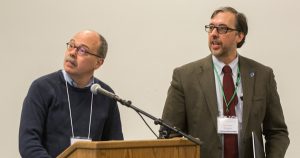
NormWagnerNeutron3: Dan Neumann and Norm Wagner stand at the lectern in the Ewing Room of Perkins Hall on Neutron Day.
Scientists Discuss Promise of New Agreement Between UD and NIST
The day began with coffee, bagels, and some hearty discussions about experimental data. The University of Delaware’s fifth Neutron Day was held Wednesday, Nov. 8 in Perkins Hall and the Patrick Harker Interdisciplinary Science and Engineering (ISE) Lab. This year, Neutron Day was a celebration of more than its namesake subatomic particle. UD’s Center for Neutron Science (founded in 2007) recently entered into another cooperative agreement with the National Institute of Standards and Technology (NIST) Center for Neutron Research (NCNR). Under this new agreement, UD’s Center for Neutron Science will advance the field of neutron scattering by developing new techniques, applying these techniques to new applications, and training the next generation of neutron scientists. The agreement began on Sept. 1 with $1.7 million of funding and projects a funding total of more than $8.7 million through Aug. 31, 2022, which brings the total funding to the center to well over $30 million over the past ten years. UD’s Center for Neutron Science is directed by Norm Wagner, the Unidel Robert L. Pigford Chair in Chemical and Biomolecular Engineering. He is a fellow of the Neutron Scattering Society of America, a regular user of NCNR facilities and a contributor to the development of neutron scattering instrumentation.
Read UDaily article
CNS Seminar
Lilo Pozzo
University of Washington
“Ultrasound and Photo-acoustic Nano-Emulsion Agents for use in Medicine”
November 15, 2017
1:00 p.m.
366 Colburn Lab
Neutron Day 2017
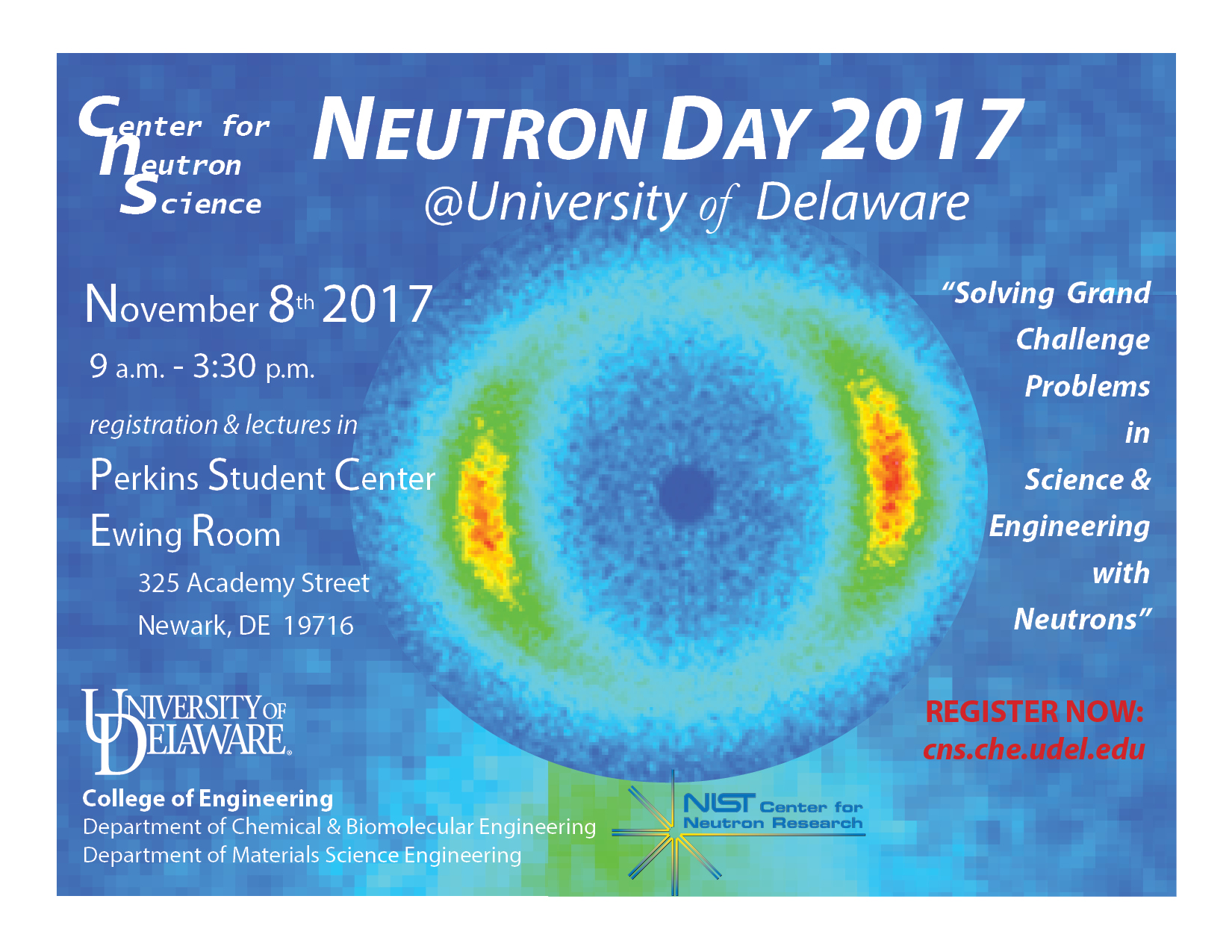
Neutron Day 2017 at Perkins Student Center, Ewing Room on November 8, 2017 from 9:00 a.m. – 3:30 p.m.
“Solving Grand Challenge Problems in Science & Engineering with Neutrons”
November 8, 2017, 9:00 a.m. – 3:30 p.m., Perkins Student Center, Ewing Room, 325 Academy Street, Newark, DE 19716
2017 Neutron Day Program, Parking Map & Building Locations: Click Here
Poster Presentation List: Click Here
Sponsored by the Center for Neutron Science
NIST Center for Neutron Research (NIST-NCNR)
University of Delaware College of Engineering
Department of Chemical & Biomolecular Engineering
Department of Materials Science & Engineering.
Center for Neutron Science, University of Delaware, and NIST Cooperative Agreement beginning September 1, 2017
Executive Summary
We propose a cooperative agreement between the Center for Neutron Science (CNS) at the University of Delaware (UD) and the NCNR to focus on advancing neutron scattering metrology through the use of SANS, VSANS, Neutron Reflectometry and NSE for research addressing grand challenges in the areas of sustainable energy, human health, nanomaterials as well as engineering the tools of scientific discovery. The goals of this cooperative agreement include the promotion and development of the use of neutron scattering science by scientists at the NCNR, NIST and the broader community in science and engineering, including macromolecular, colloid, and condensed matter science and chemistry. The seven faculty, nine NIST staff and 12 doctoral students and postdocs currently or proposed to be funded by the CNS have significant, collective experience using neutron scattering in research, and in the design, development, maintenance and optimization of neutron scattering instrumentation. The PI (Wagner) has directed the CNS at UD for a decade, is a fellow of the Neutron Scattering Society of America, was elected to the National Academy of Engineering and the National Academy of Inventors, is a regular user of the NCNR and contributes to NCNR activities and the development of neutron scattering instrumentation world-wide. Collectively, the faculty have trained over 100 doctoral students and postdoctoral scientists in neutron scattering science and have an extensive scientific publication record with high visibility, as also evidenced through many professional awards, and numerous plenary and keynote invited lectures. Many UD doctoral students are or have been in residence at the NCNR for a significant fraction of their doctoral dissertation, which stems from strong, existing collaborations with NCNR scientists, including many co-publications. At least three UD students and postdocs have recently gone on to become NRC postdoctoral fellows at the NCNR. n-SOFT research staff and industrially supported postdocs at the NCNR in collaboration with n-SOFT are a consequence of UD CNS research. The UD CNS has trained generations of undergraduate, graduate and postdoctoral students in neutron scattering methods at the NCNR, and many continue using these facilities as part of their current careers in academia and industry.
The nine, staff to be supported under this cooperative agreement have distinguished accomplishments at the NCNR, making significant contributions to the NCNR’s new data acquisition software (NICE), the development of VSANS, as well as significant scientific advances in soft matter using NCNR resources. The beamline scientists will support the SANS, USANS, VSANS and reflectometry instruments. The beamline scientist Dr. Yun Liu is also a Research Associate Professor at UD and as such, serves as the primary thesis advisor and as co-advisor for a number doctoral students, lectures on neutron scattering at UD and other Universities, as well as teaches at the NCNR summer school. The computer scientists and engineers support NICE and the computational infrastructure of the NCNR more broadly. The mechanical design and draftsman and research scientists are integral to the design, construction, and commissioning of the new VSANS instrument (planned 2018). This proposal also includes a novel collaboration with NCNR staff to develop new interfacial rheology-neutron reflectometry sample environment that will be made available to the broader scientific user community.
The UD faculty, beamline staff scientists, graduate students and postdocs are uniquely qualified to conduct the proposed research activities and to provide excellent research assistance to U.S. neutron researchers using the NCNR. The new sample environments and data analysis methods developed in this proposed work will be made available to promote neutron scattering science more broadly through the NCNR. The close proximity of UD to NCNR, extensive track record of collaborative research, publication, and teaching jointly between NCNR and UD scientists and students greatly facilitate the strong integration of the staff into the activities of the NCNR as described in the management plan. UD is also providing special, dedicated human resources to support the UD/NCNR staff, who can effectively meet the employment needs of the proposed staff. UD students, postdocs and faculty will be in residence at the NCNR during the course of this project and will contribute to the education and support of U.S. researchers using NCNR facilities. This includes expanding our K-12 activities by providing more and improved learning modules for high school science teachers through UD’s Learning Library, which were developed by UD CNS students to educate high school students in the basics of neutron scattering and its uses. CNS faculty also offer a popular graduate course in Scattering Methods in Soft Matter that will be regularly offered during the execution of this cooperative agreement, and also hosts the highly regarded biannual “Neutron Day”, which is a regional celebration of neutron science. Importantly, UD graduates educated in neutron scattering methods and science have gone on to employment at NCNR and NIST more broadly, such that this talented pool of doctoral students and postdocs to be supported under this cooperative agreement are a source of expertise for future staffing.
Improved EVA Suit MMOD Protection Using STF-ArmorTm and Self-Healing Polymers
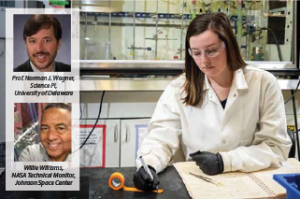
NASA EPSCoR Stimuli Highlight 2016-2017: Melisssa Gordon and Prof. Norman Wagner of the University of Delaware, and Willie Williams, NASA, Johnson Space Center
University of Delaware/NASA Johnson Space Center, Human Exploration & Operations and Space Technology Mission Directorates
As NASA propels science, technology and exploration forward, the need for spacesuits composed of lightweight, long-lived and flexible materials becomes increasingly urgent. In space, micrometeorites and orbital debris (MMOD) can compromise the air barrier of a space suit, causing pinhole punctures that are difficult to identify and repair. Our work focuses on developing healing materials capable of regenerating functionality after damage. In our approach, we are synthesizing fundamentally new, self-healing polymers in which a dynamic bond is built into the network architecture to enable a lightactivated secondary polymerization, increasing the modulus by two orders of magnitude and strengthening the network by over 100%. This work has been recently published in Advanced Materials (2015, 27, 8007–8010). We demonstrated that the material can be completely severed and then remended with increased material strength and no visible scarring. Moreover, our approach confines healing and strengthening to the damaged area; thus, an EVA suit could maintain flexibility in unaffected areas. By developing healing polymer networks, the safety and service lifetime of the material are enhanced. This material was selected by NASA to be tested on the exterior of the International Space Station in 2017 to test its response the extreme environment of outer space. See article…
Stimuli is a summary collection of college and university basic research and technology development reports impacting NASA’s earth science, aviation, and human and robotic deep space exploration programs. This document addresses research which is relevant to NASA’s mission, and currently administered by the agency’s Experimental Program to Stimulate Competitive Research.
Two Opportunities for Neutron Summer School
Summer School Fundamentals of Neutron Scattering
Purpose: A one-week “Summer School on Methods and Applications of Neutron Spectroscopy” will be held from June 19 – June 23, 2017 at the NIST Center for Neutron Research (NCNR). For information about the summer school go to: http://www.ncnr.nist.gov/summerschool/ss17/index.html. Please note that this year the school will not cover SANS or neutron reflectometry.
Target Audience: This school provides participants the opportunity to learn about a wide variety of neutron scattering techniques using instruments at NIST including the disk chopper spectrometer (DCS), backscattering spectrometer (HFBS), BT-7 double focusing triple-axis spectrometer, multi-axis crystal spectrometer (MACS), and neutron spin echo spectrometer (NSE). These powerful experimental techniques are used by researchers in a variety of scientific disciplines to probe the dynamics of materials over time scales ranging from 1 ps to 100 ns with length scales from under 1 nm to over 100 nm. This school emphasizes hands-on experimental training for the instruments mentioned above as well as a thorough theoretical overview of these measurement techniques. Applications of dynamical techniques will be illustrated by specific examples drawn from recent cutting-edge research on soft and hard condensed matter systems. The course will enable attendees to assess the applicability of the techniques to their own research, and will provide the technical information needed to prepare effective experiment proposals. Limited support for graduate students, postdocs, and junior faculty will be available. Attendance will be limited to 35 participants, and only applicants from North American institutions will be accepted.
How to Apply and for further information: For further information, and/or to apply, please go to http://www.ncnr.nist.gov/summerschool/ss17/index.html. Early application is advised since attendance is strictly limited and typically we receive more applications than the maximum number of participants. Deadline: April 11, 2017.
Conducted by: The Summer School is sponsored by the Center for High Resolution Neutron Scattering (CHRNS), jointly funded by the National Science Foundation and NIST.
Scientific Directors: Yamali Hernandez and Alex Grutter
National Institute of Standards and Technology
Tel: (301) 975-5295 (YH), (301) 975-4198 (AG)
19th National School on Neutron and X-ray Scattering August 5-19, 2017
Purpose: The main purpose of the National School on Neutron and X-ray Scattering is to educate graduate students on the utilization of major neutron and x-ray facilities. Lectures, presented by researchers from academia, industry, and national laboratories, will include basic tutorials on the principles of scattering theory and the characteristics of the sources, as well as seminars on the application of scattering methods to a variety of scientific subjects. Students will conduct short experiments at Argonne’s Advanced Photon Source and Oak Ridge’s Spallation Neutron Source and High Flux Isotope Reactor facilities to obtain hands-on experience for using neutron and synchrotron sources.
Target Audience: Graduate students attending universities in North America majoring in physics, chemistry, materials science, geosciences, engineering or related fields.
How to Apply: Applicants are encouraged to register electronically through the website at http://aps.anl.gov/nx
Jointly Conducted by: Argonne National Laboratory’s Advanced Photon Source and Materials Science Division, and Oak Ridge National Laboratory’s Neutron Sciences Directorate.
Scientific Directors: Suzanne te Velthuis, Brian H. Toby, Argonne; and Bryan C. Chakoumakos, John D. Budai, Oak Ridge.
Engineering Enhanced Cut and Puncture Resistance into the Thermal Micrometeoroid Garment (TMG) using Shear Thickening Fluid (STF) – Armor™ Absorber Layers
The low-earth orbit environment contains small micrometeoroid and orbital debris (MMOD) particles traveling at characteristic velocities of several kilometers per second. In addition to being a direct threat to astronauts and spacecraft, upon impact with the exterior surface of a space vehicle, these highly energetic MMOD particles can create cut and puncture hazards for astronauts performing extra-vehicular activities (EVA). In this work, we demonstrate that replacing the standard neoprene-coated nylon absorber layers with woven aramid textiles intercalated with colloidal shear thickening fluids, i.e., STF-Armor™, can provide a meaningful enhancement to the cut and puncture resistance of the thermal micrometeoroid garment (TMG). Quasi-static puncture testing is performed using hypodermic needles of varying gauge to simulate the cutting and puncture hazards at deformation rates characteristic of human motion. At equal areal densities, we find that a TMG lay-up containing STF-Armor™ greatly improves puncture protection with a reduction in weight and comparable flexibility.
The primary concern for spacecraft shielding engineers is mitigating the risks posed by natural micrometeoroids originating from comets and asteroids throughout the solar system [1] and [2]. Over the decades, the increasing number of vehicles and satellites launched into low-earth orbit (LEO) has broadened the focus of design engineers to manmade orbital debris threats [3] and [4]. These orbital debris particles, largely aluminum-based compounds broken off from LEO vehicles, typically travel at velocities of 1–15 km/s in LEO [2]. While generally on the order of a millimeter or less in size, these micrometeoroid and orbital debris particles (MMOD), are sufficiently energetic to be destructive upon impact. Of particular concern to manned missions is the threat posed by MMOD to astronauts as they perform extra-vehicular activities (EVA). To combat this threat, the current EVA suit consists of an assemblage of textile layers, known as the thermal micrometeoroid garment (TMG), which protects the exterior of the pressurized air bladder as shown in Fig. 1. The design of the TMG primarily seeks to prevent MMOD particles from reaching and puncturing the air bladder upon a direct impact [5]. Read More…
Senator Coons Tours the NIST Center for Neutron Research
University of Delaware Professor Norman J. Wagner, Robert L. Pigford Chair of Chemical Engineering, Affiliated Professor of the Department of Physics and Astronomy, Affiliated Professor of the Biomechanics and Movement Science Program (BIOMS), and Director of the University of Delaware Center for Neutron Science (CNS), gives a tour to United States Senator for Delaware Christopher Coons at the National Institute of Standards and Technology Center for Neutron Research in Gaithersburg, Maryland. Professor Wagner explains the University of Delaware Center for Neutron Science partnership with the National Institute of Standards Technology Center for Neutron Research (NIST-NCNR).
Dr Jeff Richards, Julie Hipp and Dr. John Riley at NIST/NCNR
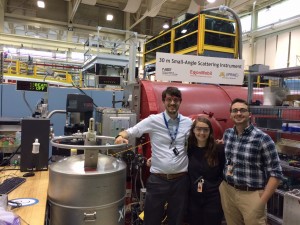
Dr Jeff Richards, NIST/UD NRC Postdoc, Ms. Julie Hipp, UD Grad student, and Dr. John Riley, UD, CNS Postdoc, perform some of the world’s first simultaneous rheo-SANS-dielectric measurements on NG7 beamline at the NCNR.
Dr Jeff Richards, NIST/UD NRC Postdoc, Ms. Julie Hipp, UD Grad student, and Dr. John Riley, UD, CNS Postdoc, perform some of the world’s first simultaneous rheo-SANS-dielectric measurements on NG7 beamline at the NCNR.
Read more about the National Institute of Standards and Technology Center for Neutron Research (NIST-NCNR)
Four Awards Were Presented to UD and Former UD Students and Faculty
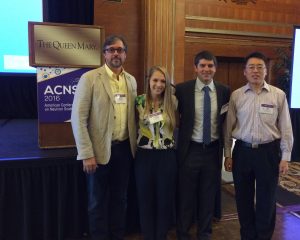
ACNS Meeting 2016 American Conference on Neutron Scattering Queen Mary in Long Beach, California: (from left to right) Norman Wagner, Michelle Calabrese, P. Douglas Godfrin, and Yun Liu
2016 American Conference on Neutron Scattering Queen Mary in Long Beach, California[/caption]
Four awards were presented to UD and former UD students and faculty at the 2016 American Conference on Neutron Scattering on the Queen Mary in Long Beach CA in July. [From left to right in picture] Prof. Norman Wagner received the Neutron Scattering Society of America’s Service Award for his work on the executive committee and long-standing efforts to raise funding for students, post docs, and young scientists to attend the meeting. Ph.D. student, Michelle Calabrese of the Department of Chemical and Biomolecular Engineering, won one of four student poster prizes out of a field of over 80 scientific posters for her work on understanding the effects of branching on the flow of self-assembled surfactants. Former PhD student, Dr. P. Douglas Godfrin, won the Best Dissertation Award, while Dr. Yun Liu, UD Research Associate Professor and NIST Beamline Scientist won the Science Prize of the ACNS. Dr. Godfrin received his PhD in 2015 for his work on understanding the properties and stability of monoclonal antibodies and protein solutions under the advisement of Prof. Wagner and Dr. Liu. The ACNS is held once every two years and is the premier North American scientific venue for presenting and discussing scientific advances afforded by neutron scattering methods.
Read more about ACNS
Of Superheroes and World Changers
Two UD professors inducted into National Academy of Inventors
You might say that curiosity got the best of University of Delaware inventors Norman J. Wagner III and the late Richard F. Heck. And we’ve undoubtedly been the beneficiaries of their scientific sleuthing and tinkering. The two were inducted as fellows into the National Academy of Inventors on Friday, April 15, in ceremonies at the United States Patent and Trademark Office in Alexandria, Virginia. Wagner, who is the Unidel Robert Pigford Chaired Professor of Chemical and Biomolecular Engineering, answered some questions for UDaily about developing superhero materials called shear thickening fluids – some that he has developed into “liquid armor” – and what it’s like to be an inventor. Read more about how ‘shear” genius provides super-hero protection…
Read more about the National Academy of Inventors

2016 Unilever Award Winner
Matthew E. Helgeson, Ph.D. in Chemical Engineering from the University of Delaware, 2009
Unilever Award is given in recognition of fundamental work in colloid or surfactant science carried out in North America by researchers in the early stages of their careers. The 2016 Unilever Award winner is Prof. Matthew Helgeson from the University of California at Santa Barbara. Matthew E. Helgeson is an Assistant Professor at the University of California, Santa Barbara. In 2004, he received a B.S. degree in Chemical Engineering from Carnegie Mellon University. In 2009, he received his Ph.D. in Chemical Engineering from the University of Delaware, where he performed doctoral research with Norman Wagner and Eric Kaler. From 2009-2012, he performed postdoctoral research in the Novartis-MIT Center for Continuous Manufacturing at the Massachusetts Institute of Technology under the supervision of Patrick Doyle. Helgeson joined the faculty of UCSB in 2012, where he holds an appointment in the Department of Chemical Engineering and is a faculty member of the Materials Research Laboratory. Read more about Helgeson’s research…
2016 Science Prize
Yun Liu
National Institute of Standards and Technology &
University of Delaware
Dr. Yun Liu is the recipient of the 2016 Prize for Outstanding Student Research Neutron Scattering Society of America (NSSA) with the citation “For the discovery of dynamic cluster ordering in complex colloidal systems using neutron scattering”. The prize and $2500 honorarium will be awarded at the 2016 ACNS in Long Beach, CA, July 10-14, 2016.
Colloidal systems are found throughout nature and pervade our daily lives. They are used in foods, paints, personal-care products, biological systems such as blood or cellular components, and modern composite materials. The physics of these systems is typically dominated by very large surface areas, which amplify the importance of surface forces and thermal fluctuations. In the concentrated systems typical of most real-world applications, the underlying interactions usually exhibit many-body effects. Moreover, the geometry of the constituent “particles” can differ markedly from that of the uniform spheres that are usually invoked to model these systems. Dr. Yun Liu has performed ground-breaking research that greatly expands our understanding of colloidal systems well beyond those that can be described by simple models to complex fluids that are far more representative of those found in nature or used in industrial processes. In the process, he discovered dynamic clusters in concentrated protein solutions and related these to previously unexplained changes in viscosity that have profound implications for the production, purification, and administration of biopharmaceutical formulations.
Dr. Liu received his PhD in 2005 from Massachusetts Institute of Technology and is a Research Associate Professor at the University of Delaware in the Department of Chemical & Biomolecular Engineering since 2014, where he also holds an affiliated Research Professorship in the Department of Physics and Astronomy. Dr. Liu is currently a Staff Scientist in the SANS/uSANS team, NIST Center for Neutron Research. UDaily Article
2016 Prize for Outstanding Student Research
P. Douglas Godfrin
Dr. P. Douglas Godfrin is the recipient of the 2016 Prize for Outstanding Student Research Neutron Scattering Society of America (NSSA) with the citation “For seminal neutron scattering studies of concentrated protein solutions and protein dynamics with application to biopharmaceutical engineering.” The prize and $1000 honorarium will be awarded at the 2016 ACNS in Long Beach, CA, July 10-14, 2016.
Concentrated protein solutions present challenges for formulators of biopharmaceuticals as well as scientists investigating the cellular environment. A key scientific question in modern protein science concerns protein structuring in concentrated solutions and how this organization arises from molecular association to lead to anomalous transport properties. A signature feature of Dr. Godfrin’s investigations into concentrated protein solutions is the combination of SANS/USANS to determine solution microstructure, with complementary measurement of the dynamics in these concentrated solutions by neutron spin echo. Combined with theory and simulation, Dr. Godfrin was able to directly probe a new liquid state of matter, the clustered fluid, discovered both experimentally and theoretically within the past 20 years, and showed how this is relevant to our understanding of the stability and transport properties of concentrated protein solutions. Furthermore, Dr. Godfrin performed these experiments on globular protein solutions, which can be successfully used to test and validate our theoretical understanding of cluster liquids, as well as on model monoclonal antibodies provided by Genentech, which are directly relevant for biopharmaceuticals used for oncology treatment. In achieving these results, Dr. Godfrin collaborated with experts in simulation methods and fundamental theory to develop a new, universal state diagram that extends the Noro-Frenkel law of corresponding states to systems with competing short-range attraction and long-range repulsive interactions. In his doctoral research, which was conducted in part at the NIST Center for Neutron Research, Dr. Godfrin also contributed to the development of the novel 1-2 plane flow SANS sample environment commissioned both at the NCNR and ILL, Grenoble France. This unique sample environment enables directly probing the microstructure via SANS in shearing samples in the plane of shear.
Dr. Godfrin graduated from the University of Delaware in June of 2015, and is currently a Postdoctoral Associate at the Massachusetts Institute of Technology. His current interests include developing pharmaceutical formulations for encapsulation of monoclonal antibodies and hydrophobic small molecule drugs in hydrogel beads to control crystal size and bead morphology in order to engineer a specific drug release profile. UDaily Article
Neutron Day 2015
Neutrons are far too tiny for the human eye to see, but they can help us “see” deep into matter and determine the properties of materials at the subatomic level.
Neutrons can behave like microscopic magnets, diffract like waves, or set particles into motion, revealing properties not available using other probes or imaging techniques.
More than 100 scientists and engineers came to the University of Delaware on Wednesday, Nov. 4, to learn about the latest developments in this technology at the fourth annual Neutron Day.
The event, “Solving Real-World Problems with Neutrons,” was held in collaboration with the NIST Center for Neutron Research (NCNR), a national resource for industry, universities, and government agencies.
Directed by Norman J. Wagner, UD’s Center for Neutron Science is a cooperative agreement between the University and the NCNR that supports over 30 faculty, students and scientists between the two institutions in cooperative research, instrumentation development and education.
“Our partnership with UD is extremely important to NIST in broadening our scientific base, improving our instrumentation, and furthering neutron science,” said NCNR director Dan Neumann. “It’s critical that we have a window to the outside in identifying real-world needs and problems.”
The day-long program featured 10 technical talks by presenters from UD, NIST, and industry, as well as some 30 student posters on topics from methane conversion to disease detection.
Students represented not only UD but several other universities as well, including Carnegie Mellon University, Georgetown University, the University of Maryland, and Indiana University.
“We are very fortunate to have such close ties with NCNR, which provides world-class capabilities in terms of both staff and physical infrastructure,” said Wagner, who is the Unidel Robert L. Pigford Chaired Professor of Chemical and Biomolecular Engineering at UD. “This technology is helping to unlock the secrets of materials at the atomic level and providing the foundation to tailor them for a broad range of medical, energy, environmental, and manufacturing applications.”
Neutron Day was sponsored by UD’s College of Engineering, Center for Neutron Science, Department of Chemical and Biomolecular Engineering and Department of Materials Science and Engineering.
Article by Diane Kukich
CNS News
-
- Doug Godfrin, jointly advised by Norman Wagner and Yun Liu was awarded the NIST Sigma Xi Most Outstanding Poster Presentation Award for Biotechnology, Biology, and Polymers. His poster, entitled: “Cluster Mediated Dynamics and Viscosity in Concentrated Protein Solutions” will be posted in the NIST Main Admin building for two weeks.
- Congratulations to Jingsi Gao, a graduate student at the University of Delaware, who won Second Place in the student poster session at the Society of Rheology’s 86th Annual Meeting in Philadelphia, PA. The title of her poster is “Rheology of dispersions in ionic liquids” with Dr. Mark Shiflett and Dr. Norman Wagner.
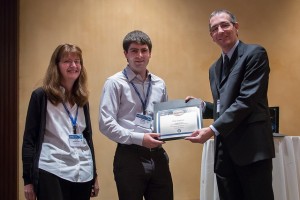 Congratulations to Doug Godfrin, a graduate student at the University of Delaware who is stationed at NCNR, who won a poster prize for his high impact work on Monoclonal Antibody Characterization at the American Conference on Neutron Scattering.
Congratulations to Doug Godfrin, a graduate student at the University of Delaware who is stationed at NCNR, who won a poster prize for his high impact work on Monoclonal Antibody Characterization at the American Conference on Neutron Scattering.- University of Delaware Professor Norman Wagner was selected as a fellow of the Neutron Scattering Society of America (NSSA)
- Congratulations to Yun Liu, material physicist in the SANS group at NIST Center for Neutron Research and a research assistant professor in the Department of Chemical & Biomolecular Engineering, for being selected to receive the 2014 NIST-Sigma Xi Katharine B. Gebbie Young Investigator Award! Yun is being recognized “For the discovery of dynamic cluster ordering in complex colloidal systems.”
Recent Events
National Academy of Engineering elects UD’s Norman Wagner — Norman J. Wagner, a University of Delaware engineering professor noted for his groundbreaking research in fluid mechanics and molecular thermodynamics, has been elected to the prestigious National Academy of Engineering.
Wagner, the Robert L. Pigford Chaired Professor of Chemical and Biomolecular Engineering at UD, is among NAE’s 67 new members and 12 foreign members.
Election to the National Academy of Engineering is among the highest professional distinctions accorded to an engineer.
Academy membership honors those who have made outstanding contributions to engineering research, practice, or education, including, where appropriate, significant contributions to the engineering literature, and to the pioneering of new and developing fields of technology, making major advancements in traditional fields of engineering, or developing/implementing innovative approaches to engineering education.
“We welcome Norm Wagner’s election to the National Academy of Engineering, a well-deserved honor that recognizes an outstanding career that has encompassed research, innovation, entrepreneurship and education,” said Babatunde Ogunnaike, dean of the College of Engineering. “This is a good day for the Department of Chemical and Biomolecular Engineering, the College of Engineering, the University of Delaware, and indeed the entire state of Delaware.” Read more…
Neutron Day – 2014 — The University of Delaware’s first “Neutron Day” symposium in 2012 drew about 30 participants. This year, the event attracted more than 100 attendees, reflecting the rapidly expanding use of neutron scattering as a research tool.
Neutron scattering, which shows the location and behavior of atoms, allows researchers to see in real time how material structure changes with variations in temperature, pressure, and magnetic or electronic fields.
The technology supports the development of new materials for a broad range of applications from drug delivery systems to nanostructured membranes for environmental and energy applications, superconducting cables, and solar cells.
The one-day event at UD brought leading scientists and engineers from the University’s Center for Neutron Science together with more than 30 scientists from the National Institute of Standards and Technology (NIST) Center for Neutron Research (NCNR). The group, which also included industrial scientists, met to discuss new areas of neutron scattering science, with an emphasis on strengths in complex fluids, macromolecular science, and condensed matter physics.
The program featured seven technical talks and more than 25 posters.
In welcoming the participants, Babatunde A. Ogunnaike, dean of the UD College of Engineering, talked about UD’s new Interdisciplinary Science and Engineering Laboratory (ISE Lab), which is enabling new work in microscopy, materials characterization, and nanofabrication.
Norman J. Wagner, director of the Center for Neutron Science, said that the center grew out of ongoing efforts at UD and NIST and strong collaborations between the two institutions. “We actually have a UD-South at NIST’s facility in Gaithersburg,” he said. “Faculty, postdocs, graduate students, engineers and scientists in residence are not only advancing the science there with NIST researchers but also serving as a bridge back to UD.” Read more…
About CNS

Small Angle Neutron Scattering pattern from a flowing self-assembled surfactant system.
The Center for Neutron Science at the University of Delaware is a cooperative agreement between the (UD) and the National Institute of Standards and Technology (NIST) Center for Neutron Research (NCNR) to explore and develop new areas of neutron scattering science, with emphasis on strengths in complex fluids, macromolecular science, and condensed matter physics. This partnership will enhance the small angle neutron scattering (SANS) capabilities of the United States, and thereby, make them available to a large scientific user community. It also help train the next generation of neutron scientists and engineers for careers in support of the national nanotechnology initiative. SANS is a powerful probe of molecular and nanoscale structure, supramolecular order and dynamics, and can be used to monitor chemical and field-induced transformations. Because the technique requires a high-flux neutron source, SANS measurements are carried out at large national facilities, of which there are only four in the US. This cooperative agreement builds on the world-recognized expertise in SANS in the Departments of Chemical Engineering and Materials Science and Engineering at the University of Delaware and their long-standing scientific collaborations with the US’ premier neutron scattering facility NCNR at NIST. The goals of the cooperative agreement include:
- the operation of SANS instrumentation at NCNR,
- exploration of new scientific applications of neutron scattering measurements,
- the development of new SANS instrumentation
- the development of new educational and training materials for use at UD, NIST and more broadly in support of the national neutron user community.
The project will include significant collaborative research with NIST scientists, and assisting visiting researchers at NCNR. A partnership between NIST and UD will help to develop novel experimental instrumentation of value to the broader research community. The outstanding educational and outreach activities of the UD faculty will be leveraged to enhance educational activities of NCNR to advance the use of neutrons by U.S. university and industrial scientists.
The UD faculty involved in this research and their associations are:
- Thomas Epps, Thomas & Kipp Gutshall Professor of Chemical & Biomolecular Engineering
- Kristi Kiick, Deputy Dean of Engineering and Professor of Materials Science and Engineering
- Raul Lobo, Claire D. LeClaire Professor of Chemical & Biomolecular Engineering and Director of the Center for Catalytic Science & Technology
- Michael Mackay, Distinguished Professor of Materials Science and Engineering
- Darrin Pochan, Chairperson, Department of Materials Science and Engineering and Professor, Materials Science and Engineering
- Christopher Roberts, Associate Professor, Chemical & Biomolecular Engineering
- Millicent Sullivan, Associate Professor, Chemical & Biomolecular Engineering
- Norman Wagner, Robert L. Pigford Chaired Professor of Chemical & Biomolecular Engineering and Affiliated Professor in Physics & Astronomy (PI), Executive Committee (Member at Large) of the Neutron Scattering Society of America
- UD employees at NIST
Scientific and Engineering Significance
The scientific research to be performed under this cooperative agreement will answer basic questions about a broad range of nanostructured materials, such as: how flow and processing affect the nanostructure and thermodynamic state of surfactant, polymers, and colloidal suspensions; how molecular structure affects the self-assembly of surfactants, nanoparticles, and macromolecules into functional materials; how nanostructured materials can be templated by surfactant micelles; what are the effects of protein structure on protein folding and function; what are the effects of the primary structure of synthetic polypeptides on folding kinetics and network formation; and, how structure directing agents create nanoporous, catalytic materials.
These scientific finds have direct engineering and societal impact in a broad range of applications, including: creating new nanostructure building blocks for functional nanodevices (such as photovoltaics and organic solar cells, photonic materials, sensors, and drug delivery agents); improving the efficacy of nanocomposite protective materials (i.e., STF-Armor™ body armor); development of new membranes for applications in fuel cells, batteries, and water purification membranes; improve the processing and efficacy of pharmaceuticals and personal care products; development of engineered nanomaterials for wound healing and tissue repair; improved coatings and adhesives; and the development of new catalysts for improved energy production.
Finally, the proposed research will also develop new instrumentation combining neutron scattering with static and dynamic light scattering, as well as applied external fields to develop novel and unique measurement capabilities for use by the world-wide neutron scattering community, as well as new methods of interpreting and analyzing SANS data to resolve molecular and nanoscale structure.
Training of Next Generation Scientists and Engineers
The cooperative agreement will support the training and education of undergraduate and doctoral students students, as well as professional research staff to work at the forefront and lead the national effort in nanoscience and nanotechnology. The training will provide a unique opportunity for students to work directly with NIST scientists on state of the art methods in neutron science by directly working on developing and operating the propose state-of-the-art neutron scattering facilities being developed at NIST under the expansion plan. These students will provide a critical, future resource for industries, national laboratories, and academic institutions working in nanotechnology and nanomaterials in direct support of the National Nanotechnology Initiative.
NIST / NCNR / SANS Background Information
SANS is also valuable to scientists in fields ranging from physics and biology to engineering, and is a key element of the instrumental ‘tool kit’ for nanoscience. The importance of neutron scattering was highlighted June 2002 by a report from the Office of Science and Technology Policy Interagency Working Group on Neutron Science, who provide as their first recommendation:
“1. The highest priority for federal investments in neutron scattering is to fully exploit the best U.S. neutron source capabilities – including the SNS – for the benefit of the broadest possible scientific community. Specifically, these investments should aim to:
- Fully develop at least 85% of available beam lines with neutron instrumentation that exceeds, or is at least competitive with international best-in-class instruments;
- Maximize the amount of beam time made available to the broad scientific community through an independent, peer-review based general user program;
- Provide resources to fully staff and support the high productivity operation of the neutron scattering instruments;
- Provide additional support for research using neutron scattering techniques.”
The same report also says “…the NIST facility is the only U.S. facility which currently provides a broad range of world-class capability…” An important goal of the partnership proposed here is to facilitate further development of NIST facilities and to support and enhance collaborations and educational activities with NIST and NCNR visiting scientists.
There is already substantial infrastructure in place at NIST to support SANS activities. The umbrella organizations are the NIST Center for Neutron Research (NCNR) and, within it, the NSF (DMR)-funded Center for High Resolution Neutron Scattering (CHRNS) (www.ncnr.nist.gov). CHRNS develops and operates state-of-the-art cold neutron scattering instrumentation for use by the general scientific community. Over 400 scientists, post-doctoral fellows and graduate students use the instruments each year, and their access is granted via a competitive proposal-based evaluation. CHRNS devotes considerable effort through summer schools, summer internships for undergraduate students, web-based tutorials and related education and outreach efforts to increase the breadth and diversity of the US neutron scattering community. The partnership proposed here will provide personnel to operate the SANS instrumentation at NCNR, NIST and take advantage both of the NCNR and CHRNS physical and staff infrastructure and the expertise of the research programs in macromolecular science and engineering, condensed matter physics, and chemistry at the University of Delaware to enhance important educational and research activities in neutron science and neutron scattering instrumentation.




